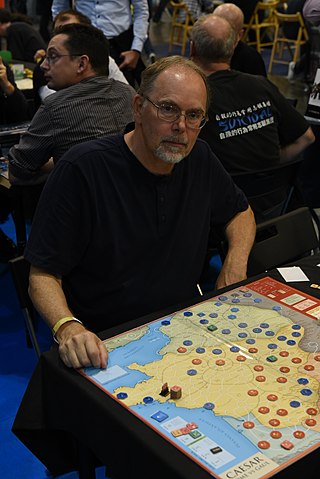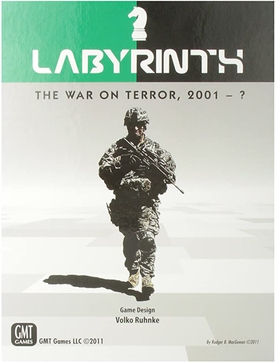
A wargame is a strategy game in which two or more players command opposing armed forces in a simulation of an armed conflict. Wargaming may be played for recreation, to train military officers in the art of strategic thinking, or to study the nature of potential conflicts. Many wargames re-create specific historic battles, and can cover either whole wars, or any campaigns, battles, or lower-level engagements within them. Many simulate land combat, but there are wargames for naval and air combat, as well.

Up Front is a World War II card-based wargame. It was designed by Courtney F. Allen and published by Avalon Hill in 1983. Hasbro now owns the franchise, and at one time licensed it to Multi-Man Publishing, a license that has since expired without republication of the game. There was an attempt to reprint Up Front through Kickstarter in 2013. The project raised over $300,000, but no updates to status has been posted since March 21, 2014.

The Charles S. Roberts Awards is an annual award for excellence in manual, tabletop games, with a focus on "conflict simulations", which includes simulations of non-military as well as military conflicts, as well as simulations of related historical topics. From its founding in 1975 through 2021, the award was almost exclusively focused on historical wargaming, changing to a broader "conflict simulations" in award year 2022.
The Labyrinth is an elaborate maze in Greek mythology.
A war game is a type of strategy game that simulates warfare realistically.

A man-to-man wargame is a wargame in which units generally represent single individuals or weapons systems, and are rated not only on weaponry but may also be rated on such facets as morale, perception, skill-at-arms, etc. The game is designed so that a knowledge of military tactics, especially at the small unit or squad level, will facilitate successful gameplay. Man-to-man wargames offer an extreme challenge to the designer, as fewer variables or characteristics inherent in the units being simulated are directly quantifiable. Modern commercial board wargaming stayed away from man-to-man subjects for many years, though once the initial attempts were made to address the subject, it has evolved into a popular topic among wargamers.

Tactical wargames are a type of wargame that models military conflict at a tactical level, i.e. units range from individual vehicles and squads to platoons or companies. These units are rated based on types and ranges of individual weaponry. The first tactical wargames were played as miniatures, extended to board games, and they are now also enjoyed as video games.
We the People is a board wargame about the American Revolution, published by Avalon Hill in 1993 and designed by Mark Herman. We the People was the first wargame to use cards as the primary way to control the pace and tempo of play, with a strong element of fog of war through the hidden card information. This started a new genre of wargames that have emphasized competitive play and a strong historical narrative.
James M. Day is an American game designer best known for military based board games, computer games, card games, and miniature rules. He is also an accomplished historian and military weaponry subject matter expert.

Twilight Struggle: The Cold War, 1945–1989 is a board game for two players, published by GMT Games in 2005. Players are the United States and Soviet Union contesting each other's influence on the world map by using cards that correspond to historical events. The first game designed by Ananda Gupta and Jason Matthews, they intended it to be a quick-playing alternative to more complex card-driven wargames.

Air wargaming, like naval wargaming, is a niche specialism within the wider miniatures wargaming hobby. Due to the relatively short time over which aerial combat has developed air wargaming periods tend to break down into three broad periods:

A board wargame is a wargame with a set playing surface or board, as opposed to being played on a computer or in a more free-form playing area as in miniatures games. The modern, commercial wargaming hobby developed in 1954 following the publication and commercial success of Tactics. The board wargaming hobby continues to enjoy a sizeable following, with a number of game publishers and gaming conventions dedicated to the hobby both in the English-speaking world and further afield.
Wargamer is a British website specialising in tabletop games, with a particular focus on miniature wargames, tabletop role-playing games, and strategic card games. It also publishes articles on various digital wargames and strategy games for the PC and other digital platforms. It is currently owned and operated by Network N. It has several sister sites, including PCGamesN, Pocket Tactics, The Loadout, and The Digital Fix, which cover video games and home entertainment respectively.

Playdek is an independent video game development company founded in 2011, based in Carlsbad, California. Playdek specializes in developing board games and card games for the iOS platform.

Mark Simonitch is an American wargame designer and graphic artist. His game designs include Hannibal: Rome vs. Carthage and Ardennes '44, and he has made maps for Wilderness War and Empire of the Sun among others. He has worked at Avalon Hill and GMT Games. He was inducted into the Charles Roberts Awards Hall of Fame in 2002.

Labyrinth: The War on Terror, 2001–? is a board game for one or two players, published by GMT Games in 2010.

Vietnam: 1965-1975 is a highly complex military and political board wargame published by Victory Games in 1984 that simulates the last decade of the Vietnam war. Published less than a decade after the end of the war, the game faced criticism from some American observers for capitalizing on a topic that was still painful to many Americans.

COIN is a series of multiplayer asymmetric strategy board wargames simulating historic insurgency and counter-insurgency conflicts and irregular warfares throughout the world. It is published by GMT Games.
The Zenobia Award is an award given to board games with a historical focus that awards designers from underrepresented groups in the industry, including games by women, people of color, and LGBT people. The award was first founded in 2020 by a number of industry experts including board game designer Cole Wehrle and Dr. Christienne Hinz of Southern Illinois University Edwardsville, who is its director. It is named after Zenobia, a queen of the Palmyrene Empire who attempted to gain control of the Roman Empire.









